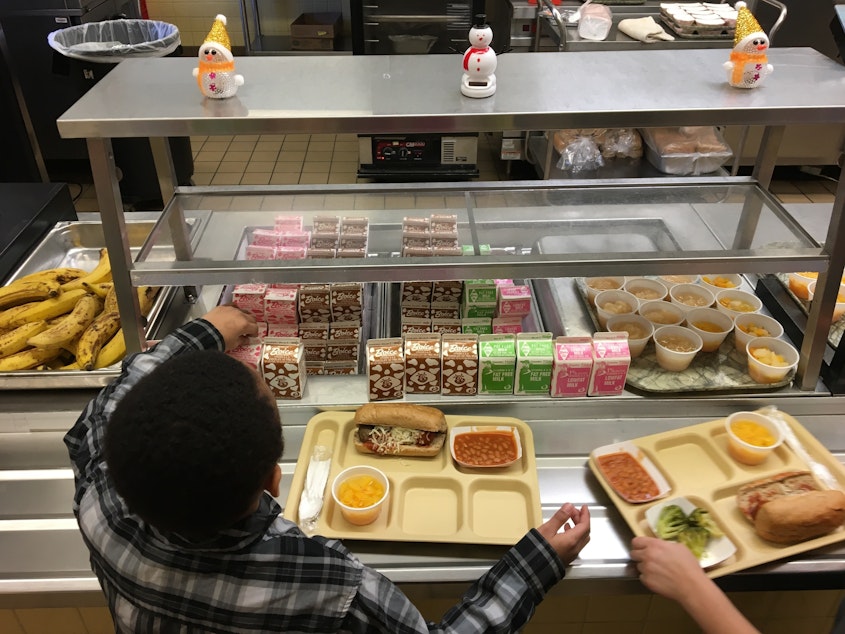Food is still short in Seattle lunchrooms, three weeks after start of school

First week of school, the lunchroom didn’t have bread.
Second week it had bread, but no French fries.
"Here we are, week three,” Garfield High School lunchroom manager Rachel Kayne said. “I have bread. I have fries. I don’t have any burgers.”
To fix the problem with persistent shortages since the beginning of the school year, Kayne and other lunchroom managers around the district say they’re swapping food among themselves so students have enough to eat.
While the Seattle School District has blamed computer system glitches on food shortages, Kayne and others say they’ve used the same system for years without problem.
Instead, lunchroom managers and their union blame administrative incompetence, lack of food in the district’s central warehouse, and a poorly timed and executed reorganization.
“It’s not the ordering system, it’s the administration,” Kayne said.
Seattle Public Schools Nutrition Services Director Aaron Smith said the first three weeks of school are not a good representation of his goals for the school food program, which include more dishes made from scratch, fresh ingredients, and culturally appropriate selections.
“The first couple weeks, we didn’t get off to the best start. We had some ups and downs and we’re looking to correct them as soon as possible,” Smith said. “There will be more options coming to the menu, there will be more vegetarian options. There will be better quality product coming.”
A week after school began, the district identified glitches in the food ordering system that were mismatching the food items’ identification codes between the front and back ends of the system, Smith said, sending the orders into a sort of cyber limbo.
Over the summer, Smith reorganized the department, he said, to reduce administrative workload, improve efficiency, and hire a head chef.
In July, two positions that lunchroom managers consider key to district-wide lunchroom logistics were eliminated. It wasn’t until September 3 that the district filled the assistant director position — the day before school started.
“It happened later than I would have liked,” Smith said.
Lack of food at the district’s warehouse caused a major problem at the beginning of the school year said Mike McBee, business manager for Local 609.
"I've walked the warehouse myself," he said, although he added things have gotten a little better now.
In response, Smith said there is indeed food in the district warehouse.
Local 609 members issued Smith a vote of no-confidence last week.
School lunchrooms are supposed to follow a menu handed down by the district, but food that’s different than the menu is still being delivered, McBee said.
“All schools aren’t able to follow the menu, there are still issues with not being able to offer vegan or vegetarian dishes, the substitutions that they’re getting are not popular with students,” he said.
For example, “some kind of waffle product” in place of pancakes.
Also, at the district “stacks and stacks” of requests to accommodate students’ dietary restrictions are still pending, McBee said.
“That’s pretty serious if it’s a food allergy,” he said.
Substitutions are causing a headache for Olympic Hills Elementary School lunchroom manager Lynne Lingafelter.
“We usually offer breakfast — two things for breakfast — I’m lucky if I get one thing to serve for breakfast,” and sometimes it’s not on the menu the district gave her, she said.
She has to explain to parents why the food is different than the menu they took home and why there are so few options, Lingafelter said.
“Last Friday we were supposed to have cheese quesadillas and (the district) sent me hamburgers. Really?”
Emails are flying between lunchroom managers with requests for additional food.
By Wednesday, Lingafelter said, she had already sent a couple schools extra frozen pizza so those lunchrooms would have enough meals to serve.
“I don’t know why the problem is continuing to happen, because there’s not a lot of schools reaching out to us letting us know there still is a problem,” Smith said.
Schools need to inform the district of problems so they can be solved as quickly as possible, he said.
“Every order, every issue that came our way that we were alerted about, we immediately contacted the warehouse, we addressed it right away and got a truck out to the school,” Smith said.




